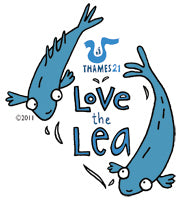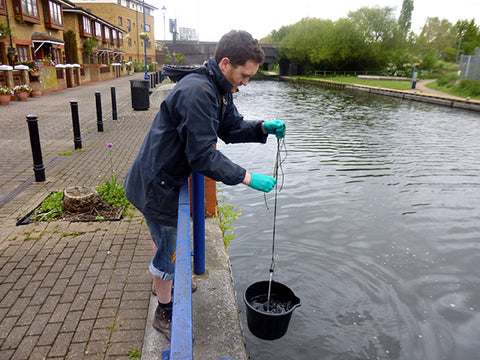CITIZEN SCIENTISTS – WATER TESTING
The Brokedown Palace is on the banks of the River Lea in Hackney Wick, London. The Lea and the Lea Valley were the original inspiration for The Brokedown Palace, and continue to inspire us everyday. Parts of the Lee Valley Park are a SSSI (Site of Special Scientific Interest) as there are many rare species of plants and wildlife here. It’s amazing to have such a space in the heart of the city, and we feel it’s very important to protect it.
 Sadly the River Lea and its tributaries are the most polluted in Britain – sewage, chemicals and oil wash into them every day. This is an issue close to our hearts, so when we heard that Theo Thomas from Thames 21 Charity had set up the Love the Lea campaign we contacted him to see if we could get involved. He suggested that we could form part of a water testers group he was setting up – Citizen Scientists who would regularly test the water at different points along the river. This data could be used to form an early warning system, and build up a clearer picture of the Lea’s health.
Sadly the River Lea and its tributaries are the most polluted in Britain – sewage, chemicals and oil wash into them every day. This is an issue close to our hearts, so when we heard that Theo Thomas from Thames 21 Charity had set up the Love the Lea campaign we contacted him to see if we could get involved. He suggested that we could form part of a water testers group he was setting up – Citizen Scientists who would regularly test the water at different points along the river. This data could be used to form an early warning system, and build up a clearer picture of the Lea’s health.
We formed a team and Theo came round to give us our testing kits to show us how it’s done.

Adam getting some river water for us to test

Filling our test tubes with river water

Adam and Rosie putting the tablets in the test tubes

Theo explains how to get the results

Phosphate level was 2, the blue looks pretty but it’s bad news for the Lea.
A Phosphate level of 1 is considered ‘bad’ by the EU Water Framework Directive. We can all help reduce river Phosphate levels by buying Phosphate free cleaning products, dishwasher tablets and detergents.

Nitrate level was 20. This indicates sewage and chemicals in the water.
Not surprising with Deephams sewage works up river at Tottenham regularly (legally) discharging raw sewage into the Lea. Also the many domestic misconnected pipes which are sending sewage into the river. Excessive amounts of nitrogen and phosphorus can cause reduced dissolved oxygen levels in the water, depriving other organisms of oxygen. Increased levels of these nutrients have also been known to cause toxic algal blooms, it also encourages duckweed. The Lea in summertime is covered in duckweed. Excess duckweed is bad for the river because it means that natural oxygen transfer from the atmosphere is greatly reduced, which is very damaging to fish.

The Ph was 8 which is within the normal range.
We’ll continue to test the water every two weeks and keep you up to date with the results.
WHAT CAN YOU DO?
- If you see anything in your local area that looks like pollution ring the Environment Agency incident hotline on 0800 80 70 60. They will investigate it.
- Pledge to LOVE THE LEA with Thames 21
- Use Phosphate-free household products – most supermarkets do a range or try Ecover
- Download this handy LOVE THE LEA information leaflet and share with friends and family
- Check your household connections – most people whose pipes are misconnected have no idea they are discharging sewage and waste water into our rivers. More information on connectright.org.uk
- Like LOVE THE LEA on Facebook
- Follow @TheoJThomas on Twitter and hashtags #lovethelea and #leatest to keep up-to-date with the LOVE THE LEA campaign
For more information contact Theo Thomas: theo.thomas@thames21.org.uk 020 7093 6385

